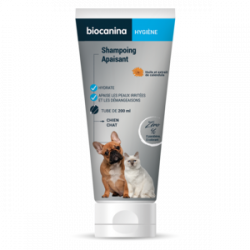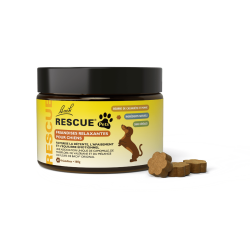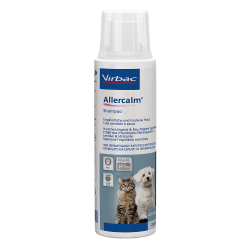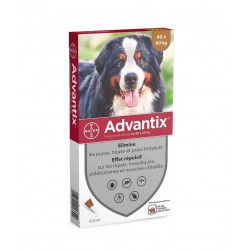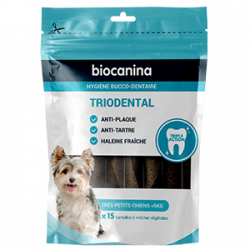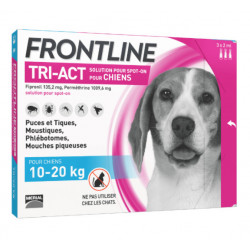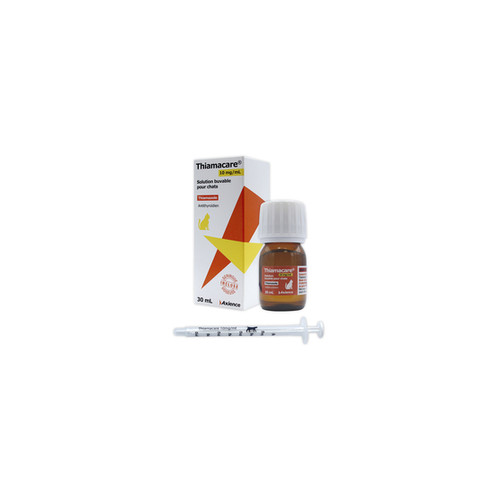



Drinkable solution.
Clear, homogeneous liquid, colorless to pale yellow.
Stabilization of hyperthyroidism in cats prior to thyroidectomy.
Long-term treatment of feline hyperthyroidism.
Specific References
Do not use in cats with systemic disease such as primary liver disease or diabetes mellitus.
Do not use in cats showing signs of autoimmune disease.
Do not use in animals with white blood cell abnormalities such as neutropenia and lymphopenia.
Do not use in animals with platelet abnormalities and coagulopathy (particularly thrombocytopenia).
Do not use in cats with hypersensitivity to thiamazole or any of the excipients.
Do not use in pregnant or nursing females (see "Use during gestation, lactation or egg-laying").
1. Name of the veterinary medicinal product
THIAMACARE 10 MG/ML ORAL SOLUTION FOR CATS
2. Qualitative and quantitative composition
One mL contains :
Active substance(s):
Thiamazole ....................................... 10.00 mg
For a full list of excipients, see "List of excipients".
3. Pharmaceutical form
Oral solution.
Clear, homogeneous liquid, colorless to pale yellow.
4. Clinical information
4.1. target species
Cats.
4.2 Indications for use, specifying target species
Stabilization of hyperthyroidism in cats prior to thyroidectomy.
Long-term treatment of feline hyperthyroidism.
4.3. Contraindications
Do not use in cats with systemic disease such as primary liver disease or diabetes mellitus.
Not for use in cats showing signs of autoimmune disease.
Do not use in animals with white blood cell abnormalities such as neutropenia and lymphopenia.
Do not use in animals with platelet abnormalities and coagulopathy (particularly thrombocytopenia).
Do not use in cats with hypersensitivity to thiamazole or any of the excipients.
Do not use in pregnant or nursing females (see "Use during pregnancy, lactation or egg-laying").
4.4. warnings specific to each target species
To improve stabilization of the hyperthyroid cat, it is necessary to respect the same timing of feed distribution and treatment administration each day.
4.5. Special precautions for use
i) Special precautions for use in animals
If a dose higher than 10 mg per day is required, animals must be monitored particularly carefully.
In case of renal insufficiency, the benefit/risk ratio must be carefully assessed by the clinician before use in cats. As thiamazole can reduce glomerular filtration rate, the effects of treatment on renal function must be closely monitored, as deterioration of underlying pathology is likely to occur.
Hematological monitoring is necessary because of the risk of leukopenia or hemolytic anemia.
Any animal that suddenly appears to deteriorate during treatment, particularly if febrile, should have blood drawn for routine haematological and biochemical tests. Neutropenic animals (neutrophils < 2.5 x109/L) should receive prophylactic treatment with bactericidal antibacterials and supportive therapy.
See "Dosage and administration" for monitoring instructions.
Since thiamazole can cause hemoconcentration, cats should always have access to drinking water.
ii) Special precautions to be taken by the person administering the veterinary drug to animals
Persons with a known hypersensitivity (allergy) to thiamazole or any of the excipients should avoid contact with the veterinary drug. If allergic symptoms appear, such as skin rash, swelling of the face, lips or eyes, or breathing difficulties, seek medical advice immediately and show the package leaflet or label.
Thiamazole may cause gastrointestinal disorders, headaches, fever, joint pain, pruritus (itching) and pancytopenia (reduced red blood cell and platelet counts).
The veterinary drug may also cause skin irritation.
Avoid dermal and oral exposure, including hand-to-mouth contact.
Do not eat, drink or smoke while handling veterinary drug or used litter.
Wash hands with soap and water after administering and handling veterinary drug, and after cleaning up vomit or litter used by treated animals. Immediately wash off any splashes or sprays on the skin.
After administration of the veterinary drug, any residue of veterinary drug remaining on the tip of the administration syringe should be wiped off with a tissue. The contaminated tissue should be disposed of immediately.
The syringe should be kept with the veterinary drug in the original cardboard box.
In the event of accidental ingestion, seek medical advice immediately and show the package leaflet or label.
This veterinary drug may cause eye irritation.
Avoid all contact with eyes, including contact between hands and eyes.
In case of accidental eye contact, immediately flush eyes with clean running water. If irritation occurs, seek medical advice.
As thiamazole is suspected of being teratogenic in humans, women of childbearing age should wear single-use waterproof gloves when administering the veterinary drug or handling the litter/vomit of treated cats.
If you are pregnant, think you may be pregnant or are planning to become pregnant, you must not administer the veterinary drug or handle the litter/vomit of treated cats.
iii) Other precautions
No other precautions.
4.6. Adverse reactions (frequency and severity)
Adverse reactions have been reported following long-term treatment of hyperthyroidism. In a large number of cases, the signs are mild and transient, and do not justify discontinuation of treatment. More serious effects are mostly reversible on discontinuation of the drug.
Adverse events are infrequent. The most frequently reported clinical adverse reactions are: vomiting, inappetence/anorexia, lethargy, severe pruritus and excoriations of the head and neck, hemorrhagic diathesis and jaundice associated with liver disease, and hematological abnormalities (eosinophilia, lymphocytosis, neutropenia, lymphopenia, mild leukopenia, agranulocytosis, thrombocytopenia or hemolytic anemia). These side effects disappear within 7 to 45 days of stopping thiamazole treatment.
Anemia accompanied by thrombocytopenia and the appearance of serum anti-nuclear antibodies occurs rarely.
Lymphadenopathy occurs very rarely. Treatment should be discontinued immediately and alternative therapy considered after a sufficiently long convalescence period.
After long-term treatment with thiamazole in rodents, an increased risk of thyroid tumor development has been observed, but there is no scientific evidence for this in cats.
The frequency of adverse reactions is defined as follows:
- very frequent (adverse reactions occurring in more than 1 in 10 treated animals)
- frequent (between 1 and 10 animals out of 100 treated)
- uncommon (between 1 and 10 animals out of 1,000 treated)
- rare (between 1 and 10 animals out of 10,000 treated)
- very rare (less than 1 in 10,000 animals treated, including isolated cases).
4.7. Use during pregnancy, lactation or egg-laying
Laboratory studies in rats and mice have demonstrated teratogenic and embryotoxic effects of thiamazole. The safety of thiamazole in cats has not been established during gestation or lactation. Do not use in pregnant or nursing females. See "Pharmacokinetic characteristics".
4.8. Drug interactions and other forms of interaction
Concurrent treatment with phenobarbital may reduce the clinical efficacy of thiamazole.
Thiamazole is known to decrease the hepatic oxidation of benzimidazole-type dewormers, and may induce an increase in their plasma concentrations when co-administered.
As thiamazole is an immunomodulator, this should be taken into account when considering vaccination programs.
4.9. Dosage and route of administration
Oral administration.
Veterinary medicine should be administered directly into the cat's mouth. Do not administer in food, as the efficacy of the veterinary drug when administered in this way has not been established.
For stabilization of feline hyperthyroidism prior to thyroidectomy, and for long-term treatment of feline hyperthyroidism, the recommended initial dose is 5 mg thiamazole (0.5 mL veterinary drug) per day.
The total daily dose should be divided into two doses and administered morning and evening. To improve stabilization of the hyperthyroid cat, it is necessary to use the same regimen of veterinary drug administration in relation to the diet each day.
Hematological and biochemical parameters and total serum T4 should be assessed before starting treatment, then after 3 weeks, 6 weeks, 10 weeks, 20 weeks and every 3 months thereafter. At each of the recommended monitoring intervals, the dose should be adjusted according to effect, total T4 and clinical response to treatment. Adjustments to the standard dose should be made in increments of 2.5 mg thiamazole (0.25 mL veterinary drug), with the aim of achieving the lowest possible dose. For cats requiring particularly small dose adjustments, increments of 1.25 mg thiamazole (0.125 mL product) can be used. If the total T4 concentration falls below the lower limit of the reference range, and in particular if the cat shows clinical signs of iatrogenic hypothyroidism (e.g. lethargy, inappetence, weight gain and/or dermatological signs such as alopecia and dry skin), consideration should be given to reducing the daily dose and/or frequency of administration.
If a dose higher than 10 mg of thiamazole per day is required, animals should be monitored particularly closely.
The dose administered should not exceed 20 mg thiamazole per day.
For long-term treatment of hyperthyroidism, the animal must be treated for life.
4.10. Overdosage (symptoms, emergency treatment, antidotes), if necessary
In tolerance studies in young, healthy cats, the following dose-related clinical signs were observed at doses of up to 30 mg thiamazole/animal/day: anorexia, vomiting, lethargy, pruritus and haematological and biochemical abnormalities such as neutropenia, lymphopenia, decreased serum potassium and phosphorus concentrations, increased serum magnesium and creatinine concentrations and the appearance of anti-nuclear antibodies. At a dose of 30 mg thiamazole/day, some cats showed signs of hemolytic anemia and severe clinical deterioration. Some of these signs may also occur in hyperthyroid cats treated with doses of up to 20 mg thiamazole/day.
Excessive doses in hyperthyroid cats may produce signs of hypothyroidism. This is unlikely, however, as hypothyroidism is generally corrected by negative feedback mechanisms. See "Adverse reactions (frequency and severity)".
In the event of overdosage, discontinue treatment and administer symptomatic and supportive therapy.
4.11. withdrawal time
Not applicable.
5. Pharmacological properties
Pharmacotherapeutic group: antithyroid preparations: sulfur imidazole derivatives.
ATC-vet code: QH03BB02.
5.1. Pharmacodynamic properties
Thiamazole acts by blocking thyroid hormone biosynthesis in vivo. Its main action is to inhibit iodine binding to thyroid peroxidase, thus preventing catalytic binding of iodine to thyroglobulin and synthesis of T3 and T4.
5.2. Pharmacokinetic characteristics
Following oral administration to healthy cats, thiamazole is rapidly and completely absorbed, with bioavailability > 75%. However, there is considerable variability between animals. Elimination of the drug from cat plasma is rapid, with a half-life of 2.6 to 7.1 hours. Peak plasma concentration occurs within 1 hour of administration. Cmax is 1.6 ± 0.4 μg/mL.
In rats, thiamazole has been shown to be weakly bound to plasma proteins (5%), with 40% bound to red blood cells. The metabolism of thiamazole in cats has not been studied; in rats, however, thiamazole is rapidly metabolized. In humans and rats, the drug is known to cross the placenta and concentrate in the fetal thyroid gland. There is also a significant degree of passage into breast milk.
6. Pharmaceutical information
6.1. List of excipients
Glycerol
Liquid sorbitol (non-crystallizable)
Vanillin
6.2. major incompatibilities
In the absence of compatibility studies, this veterinary drug must not be mixed with other veterinary drugs.
6.3. Shelf life
Shelf life of veterinary medicinal product as packaged for sale: 2 years.
Shelf life after first opening of immediate packaging: 3 months.
6.4. Special storage precautions
Keep bottle tightly closed.
6.5. Nature and composition of immediate packaging
Type III amber glass vial with syringe adapter white translucent polypropylene
Child-resistant screw cap white polypropylene
Clear polypropylene syringe graduated from 1.25 mg to 10 mg
6.6. Special precautions for disposal of unused veterinary medicinal products or waste products derived from the use of these medicinal products
Any unused veterinary medicinal products or waste derived from the use of these products must be disposed of in accordance with local requirements.
7. Marketing authorization holder
ECUPHAR
LEGEWEG 157-I
8020 OOSTKAMP
BELGIUM
8. Marketing authorization number(s)
FR/V/6748647 0/2020
Box of 1 bottle of 30 mL and 1 syringe for oral administration of 1 mL
GTIN 03760087153361
Not all presentations may be marketed.
9. Conditions of supply
List I. Veterinary use. Respect prescribed doses. Prescription only.
10. Date of first authorization/renewal of authorization
12/03/2020
11. Text update date
12/03/2020
To improve stabilization of hyperthyroid cats, it is essential to follow the same feeding and treatment schedule each day.
Oral administration.
Veterinary medication should be administered directly into the cat's mouth. Do not administer it in the food, as the efficacy of the veterinary drug when administered in this way has not been established.
For stabilization of feline hyperthyroidism prior to thyroidectomy, and for long-term treatment of feline hyperthyroidism, the recommended initial dose is 5 mg thiamazole (0.5 mL veterinary drug) per day.
The total daily dose should be divided into two doses and administered morning and evening. To improve stabilization of the hyperthyroid cat, it is necessary to use the same regimen of veterinary drug administration in relation to the diet each day.
Hematological and biochemical parameters and total serum T4 should be assessed before starting treatment, then after 3 weeks, 6 weeks, 10 weeks, 20 weeks and every 3 months thereafter. At each of the recommended monitoring intervals, the dose should be adjusted according to effect, total T4 and clinical response to treatment. Adjustments to the standard dose should be made in increments of 2.5 mg thiamazole (0.25 mL veterinary drug), with the aim of achieving the lowest possible dose. For cats requiring particularly small dose adjustments, increments of 1.25 mg thiamazole (0.125 mL product) can be used. If the total T4 concentration falls below the lower limit of the reference range, and in particular if the cat shows clinical signs of iatrogenic hypothyroidism (e.g. lethargy, inappetence, weight gain and/or dermatological signs such as alopecia and dry skin), consideration should be given to reducing the daily dose and/or frequency of administration.
If a dose higher than 10 mg of thiamazole per day is required, animals should be monitored particularly closely.
The dose administered should not exceed 20 mg thiamazole per day.
For long-term treatment of hyperthyroidism, the animal must be treated for life.
